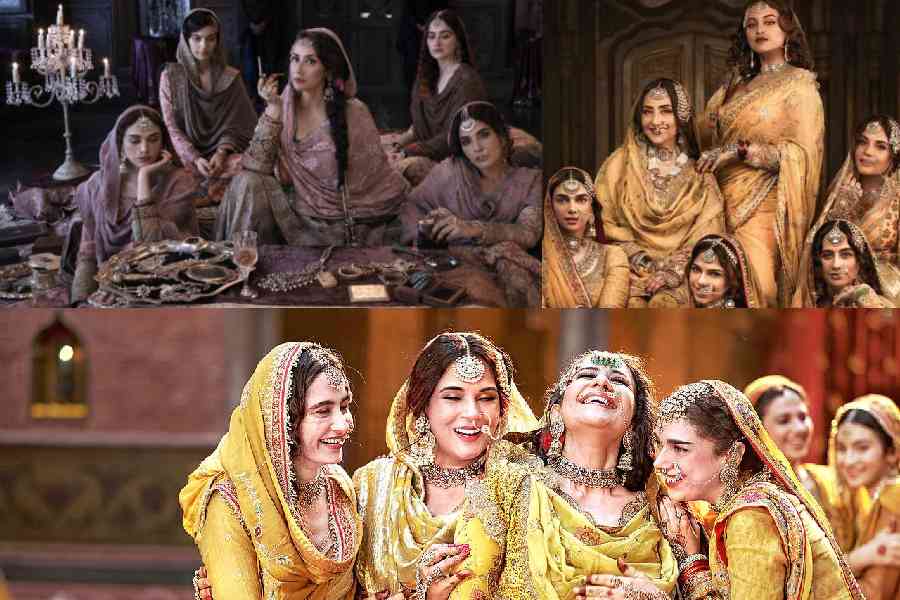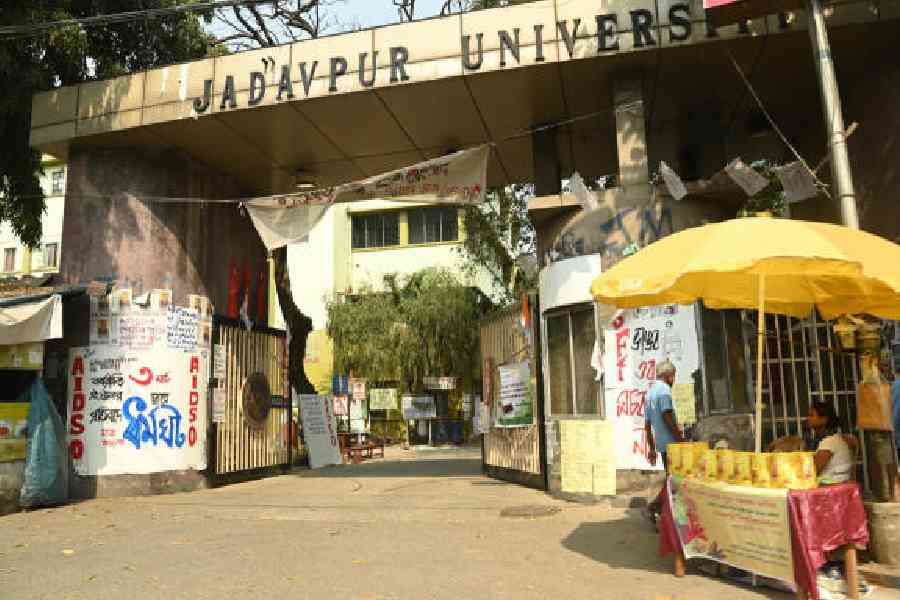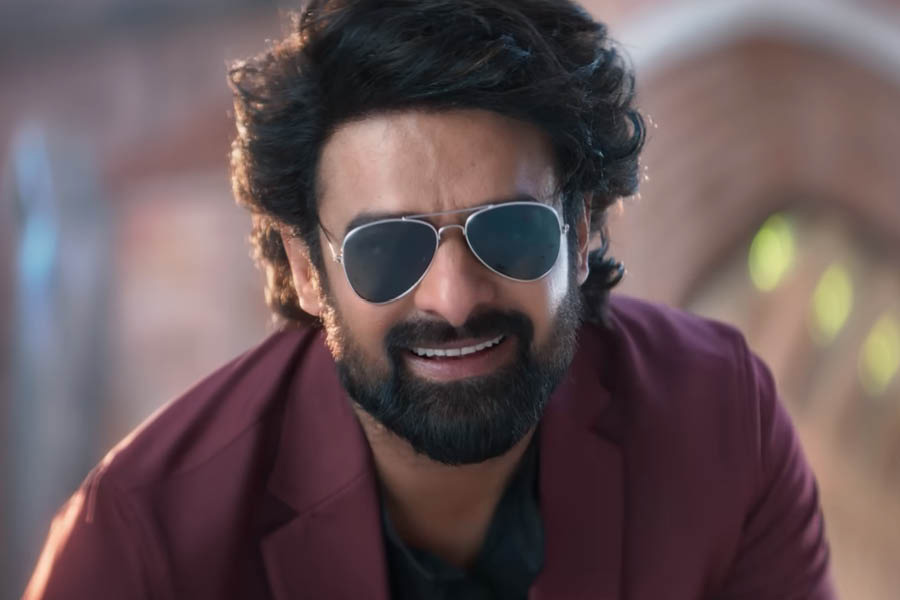It is a Sanjay Leela Bhansali world and we are just living in it. Or that is at least what we would like to dream. The auteur — whose stories have soul and substance even as they are mounted as lavish, larger-than-life epic productions — makes his long-awaited web series debut with Heeramandi.
The Netflix series, streaming from May 1, chronicles a tale of love and loss, power and vulnerability, good and evil, told from the point of view of six courtesans in pre-Independence India, who call the shots in some ways but are also powerless in more ways than one.
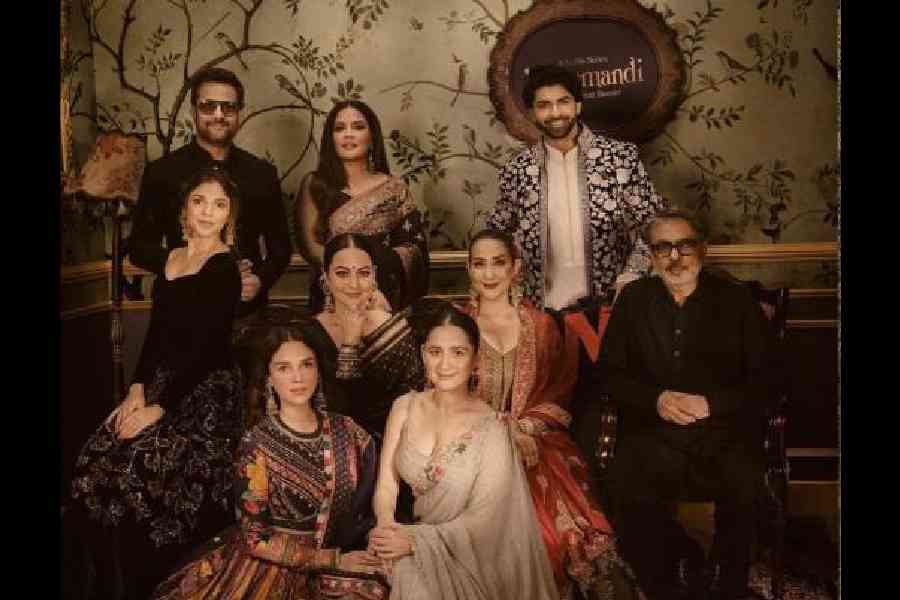
Sanjay Leela Bhansali (extreme right) with the cast of Heeramandi, comprising Fardeen Khan, Richa Chadha, Taha Shah Badussha, Sharmin Segal Mehta, Sonakshi Sinha, Manisha Koirala, Aditi Rao Hydari and Sanjeeda Sheikh
Bringing to life Bhansali’s vision are actors Manisha Koirala, Sonakshi Sinha, Aditi Rao Hydari, Richa Chadha, Sharmin Segal Mehta and Sanjeeda Sheikh.
Earlier this month, we met the six actors at the Taj Palace in Delhi for a chat on the world of Heeramandi, the magic of SLB and the status of women then and now. A t2oS exclusive...
Apart from the fact that Heeramandi is a Sanjay Leela Bhansali mega project, was there anything specific about the setting or the soul and substance of your respective characters that made you want to do this?
Manisha Koirala: Initially, it was the attraction to work with Sanjay Bhansali because the movies that he has made and the way he has portrayed his stories has not been done by anyone else. As I started working on Heeramandi, I discovered a lot more layers to the story as well as to my character, Mallika Jaan. All of that came in later, but at the start, it was just Sanjay Leela Bhansali.
Manisha, you were his first heroine, having starred in his debut directorial Khamoshi. Did Heeramandi feel like a homecoming of sorts?
Manisha: It was. I still have such vivid memories of working in Khamoshi (1996). The environment was so beautiful and there was such joy in working with a director who had passion, a filmmaker who wanted to tell stories from a woman’s perspective. In Khamoshi, it is Annie’s (Manisha’s character) voice that narrates the story. Working in Khamoshi was such a satisfying experience and I have craved for the same all these years. It is a different level of joy for an actor when you are directed by someone like him.
Richa Chadha: There is, of course, always the greed to work with him. His first series outing is a dream for any actor to be attached with. But I also wanted to do something that I hadn’t done before, whether it was a lip-sync song or a classical dance performance. I am labelled as someone who only does powerful roles and Heeramandi gave me the opportunity to play a woman (Lajjo) who isn’t so powerful. I wanted to explore that emotion which was so different from my real life.
Sharmin Segal Mehta: For me, it is about how Sanjay sir makes characters from a different period relatable to people today. It is gratifying to watch an audience connect to a character that they have no understanding of. They are buying everything that we are selling them. To be able to do that, the challenge for an actor is to be convinced of the motivations and ethics of the character and then put it out there to the audience. That happens quite effortlessly when an actor works with Sanjay Sir. It is his world and we are just the players.
Sanjeeda Sheikh: I was very happy to be a part of this world and to play a character as complex as Waheeda. This series is written like a symphony. There are so many layers that each of our characters has, so many different emotions...
And every character has so many shades of grey...
Sanjeeda: Yes, lots. That is the beauty of this world. We play tawaifs (courtesans) but under that veil there is so much sadness, so many backstories, there is baggage. And our characters have to hide all those things and present themselves like queens to the world. As actors, we knew that if Sanjay sir told us: ‘Khadi ho ja uss corner mein aur kuch mat bol’, he would still bring out the best in us. Even the silences in his frames have so much soul.
Aditi Rao Hydari: One can’t deny the fact that the chief motivation for all of us to do Heeramandi was Sanjay sir. I truly love him... I love the worlds he creates. I love how he challenges and nurtures actors. To be on his set is a blessing in every way.
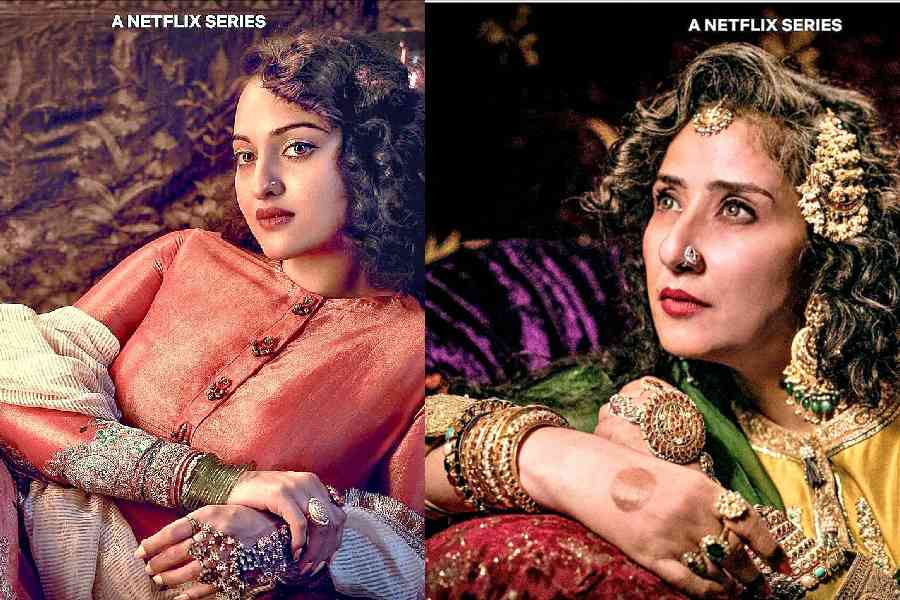
Sonakshi Sinha as Fareedan, Manisha Koirala as Mallika Jaan
Also, what spoke to me in Heeramandi is that it partly reflects some part of my own childhood and my own history. My mother (classical musician Vidya Rao) got a Ford Foundation grant to learn Thumri Dadra. It was part of her research and I have grown up hearing stories about tawaifs. My mother doing Thumri riyaz is a big part of my childhood memories. In some way, it has been part of my collective consciousness.
Heeramandi brings out the story of these women in such a beautiful way. For the world, these women are damned, they are considered dishonourable women but because of how Sanjay sir looks at women, Heeramandi looks at them as artistes. These are actually very empowered women in many ways.
To be part of this world was very exciting for me, and also for my mother. In fact, she had no idea about the world of Heeramandi until very recently when she saw the song Sakal ban from the series. She called me very excitedly and said it was done very authentically... the musicality, the voice. Sanjay sir’s sense of music is of a different level... he is a magician in every way possible. There is no jhoothapan (untruth) in what he brings to the screen. So it all started with Sanjay sir and me being a big fan of his work.Sonakshi Sinha: I love the way he projects his women on screen. When he came to me with this role, I knew it was going to be very special. That is all I needed to come on board.
Manisha, Aditi and Richa have worked with Sanjay Bhansali earlier and very successfully so, in Khamoshi, Padmaavat and Ram-Leela, respectively. Did all of you discover a new facet to yourselves as actors after working in Heeramandi?
Manisha: Absolutely! l think all of us have discovered new levels of our capacity as actors during the process of making Heeramandi. It has been so enriching for me at this stage of my career.
Sharmin: I worked with Sanjay sir as an assistant director before I worked with him as an actor and I have had the chance to observe him at work in different capacities and through varied lenses. I would describe him as an ideal director, he knows everyone’s job so well that he brings out the best in you, tenfold more than perhaps anyone else can. I have seen him take my acting ability and magnify it for the world to see.
Isn’t being on a set where everything needs to be perfect all the time too much pressure?
Sharmin: The only time you feel the pressure is when you feel like you are not doing justice to his vision. If he has the ability to see you better than what you are and you feel like you are not delivering to his level, you feel the pressure.
Aditi: I feel my anger levels rise when I am unable to deliver.
Aditi, it is difficult to believe you can get angry...
Aditi: I actually end up crying when I get angry! Sonakshi: What I truly rediscovered about myself on the set of Heeramandi is that I am very patient. For a large part of my life, I have had people telling me that I am very patient, chill and calm in stressful situations. It was while working on this project that I realised that I truly am!
You do need some level of resilience and patience to pull off something of this magnitude. We had so many people on set, so much going on in terms of the size of the set, costume, jewellery, the combination of scenes, Sanjay sir’s need for perfection.... So far, I have been happy with the imperfections that I have had as an actor. I feel that has worked for me in my career. But when it is someone like him who is constantly expecting perfection out of you, you have to give him that. That is something that I learnt on this project.
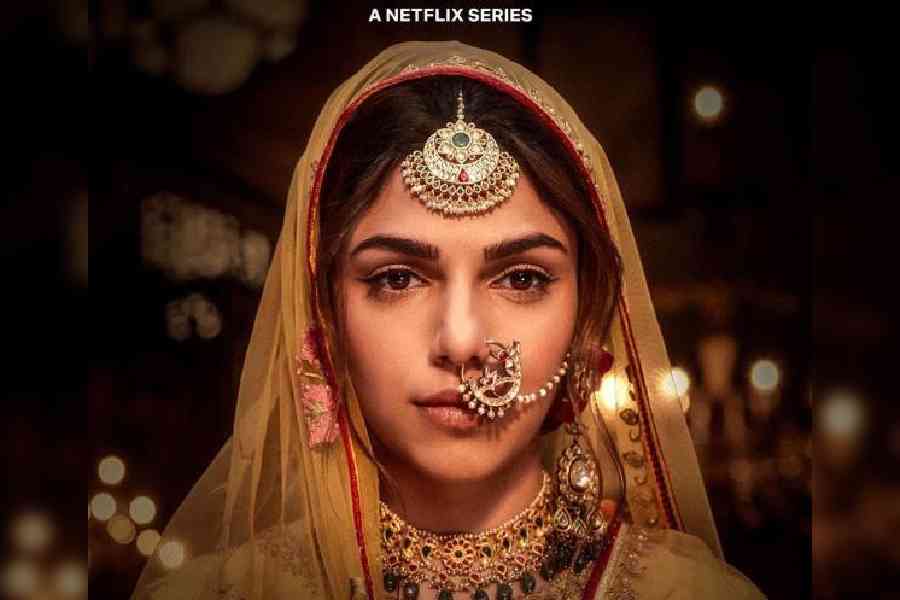
Sharmin Segal Mehta as Alamzeb
Aditi: I can totally vouch for this! We were shooting a Guild Hall scene and there was chaos! Everyone was operating at their own level of craziness (laughs) and Sona was just standing in a corner patiently. I went up to her and hugged her and said: ‘Give me your patience! I really need this!’ (Everyone laughs) Her internal chill level is huge.
Sanjeeda: I am a more polished actor after working with sir. Every time he would enter the set, it would feel like his first time because of the kind of hard work and perseverance he brings in.
Working on Heeramandi has also enhanced my technical knowledge. I feel that I now have better understanding of the camera, costume department, lights, art direction. I am a more rounded performer now.
Richa: What I discovered about myself was my ability to have laser-sharp hyper focus. The shoot of the song in which I dance solo was scheduled 10 days before my wedding and at the same time, I had my first film as a producer going on the floors. I just had a few days to prepare and I had to tell Ali (Fazal, actor and husband) to handle our production job because I knew that Heeramandi would demand everything that I had within me.
Ali saw how nervous I was because Heeramandi is very era-specific and I had to be absolutely bang on with what I did. He introduced me to the work of some legendary Bollywood dancers like Minoo Mumtaz, who is virtually unknown, and also showed me Umrao Jaan once again. Minoo Mumtaz was fantastic. She was comedian Mehmood’s sister and she has done a mujra in Guru Dutt’s Sahib Bibi Aur Ghulam, which is otherworldly... I don’t know any actress alive today who can pull off what she did. She operated at the rate of three expressions per second!
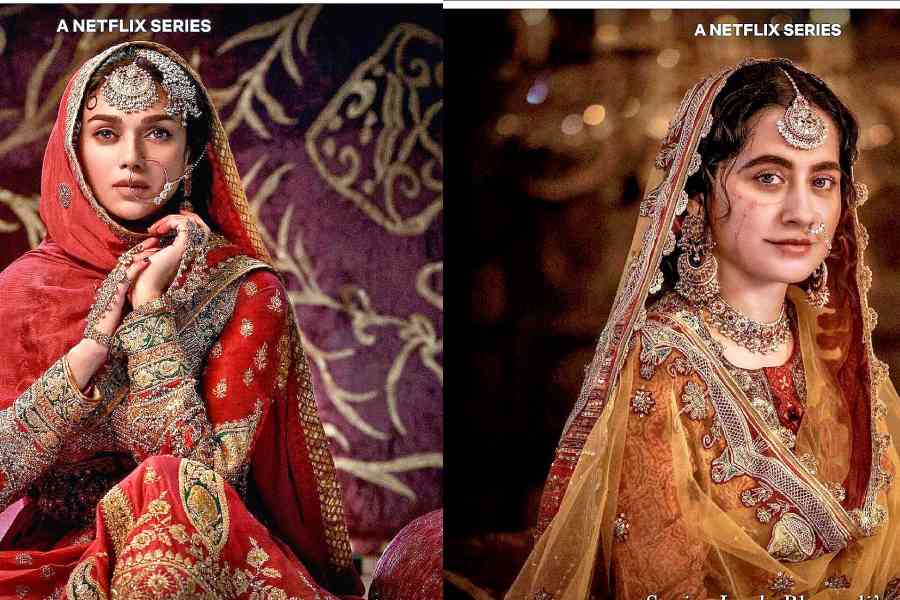
Aditi Rao Hydari as Bibbo Jaan, Sanjeeda Sheikh as Waheeda
I completely immersed myself in that world. I remember going to bed with those visuals, that mood, that Pakeezah-type ka halka sa nazar uthake dekhna aur phir rona kind of stance. I had to get into the mindset of a tawaif of the 1940s and that was tough.
I had to do this song where I was dancing with abandon and crying at the same time. My character’s heart was breaking with each step she took on the dance floor. It was the hardest thing I have ever done. For me, that crying was real. It was the culmination of doing that song for seven-eight days in front of the camera, doing some 99 takes and not getting it right. I finally had to cut other things and get sharp with my focus because I didn’t know when I would be on a Sanjay Bhansali set again.
These are very interesting women... they are both powerful in many ways and yet disempowered. What did you have to do to build empathy for them?
Manisha: Our characters are very different from who we are in life. But as an actor, we have to get to a place where we have to understand the character’s mindset, how she thinks consciously and subconsciously, what are the insecurities, vulnerabilities and cunning traits of these characters... every actor has a different approach to understanding these things.
As Manisha, I had to comprehend so many things about Mallika Jaan... why is she so evil and yet so vulnerable? If that clarity comes into your head when you are reading a script or when you are sitting with the director and he is narrating the story to you... woh sur agar main pakad leti hoon toh mere liye baaki cheezein easy ho jaate hain, whether it is costumes, lines, 99 retakes.... If you pick up the sur of the character early on, then it becomes a joyful process.
Sharmin: As an actor, you need to build empathy but not judgment. You have to empathise with them to be able to justify why they are doing what they are doing. You will never be able to convince an audience if you don’t have empathy for your character.
Manisha: Even if a person is evil, you need to get to the core to gauge what makes them so. You will automatically find a certain empathy growing within you.
Richa: Context is very important.
Aditi: A lot of it also came from how Sanjay sir presented these women to us... what they are going through, what their subconscious memories are and what their context of action and emotion is. I remember once he narrated a scene to Manisha maam and me and he went into what our characters were feeling. The way he spoke was so moving that my tears started rolling. He does it with so much belief himself that you really feel it.
I tend to be a little dreamy. But while working on this, as Richa said, I needed to have hyper focus. My empathy for Bibbo Jaan (her character) came from the information, both factual and emotional, that Sanjay sir passed on to me about her. It was very moving, it felt heady and yet liberating at the same time. It somehow became easier for me to find empathy through how he perceived my character. He is an incredible teacher. Sometimes, I would be so much into Bibbo Jaan and so charged as an actor, I would tell him: ‘Please roll, please roll! Let’s do the scene!’
If you had the option to play any character other than who you play in Heeramandi, which one would you pick?
Manisha: Given the age and stage at which I am in my life, I would want to play Mallika Jaan. No one else.
Sonakshi: I am hearing so much about Richa’s role — I haven’t seen anything of it — so I would really like to try that part.
Richa: I would like to play Fareedan, Sonakshi’s character. But it may also become a little stereotyped... kyunki main bahut qatl-e-aam kar chuki hoon! (Laughs)
Sharmin: I am a bit of a don, so I would love to play MJ! (Mallika Jaan)
Sanjeeda: I would opt for Bibbo. The person I play is so complex and crazy...
Richa: But I love her! Aditi: Yes, she has a very haunting presence. These women may come across as negative in bits and parts, but they are just being human.
Richa: The women in Heeramandi are just dealing with their lives, like we all are, every day.
There is a moment early in the series where Richa’s Lajjo says that a woman’s biggest enemy is her dreams. Do you think that holds true even today for most women, even though we are living in a seemingly more evolved society, in this country?
Richa: I don’t think it is a question of evolution, it is a question of privilege. We are an extremely privileged lot, not only in terms of wealth or where we come from or growing up in urban households. In India, being educated is a privilege, having primary health care access is a privilege. I am in my seventh month of pregnancy and people tell me: ‘Oh, you are such a trooper’. But I am sitting here in a five-star hotel and someone is coming and saying: ‘Baby, juice le lo,’ another is asking me if I am comfortable... that is so much privilege!
The remnants of that period we show in Heeramandi can be found even today, whether it is Sonagachi (in Calcutta), GB Road (in Delhi) or Kamathipura (in Mumbai). They speak of a time when these women led lives driven by royal patronage. I am not justifying it. I am just saying that in Japan also, if you see what life for the Geishas was like and what it has come down to today, it is quite tragic.

Richa Chadha as Lajjo
I have worked with some women for rehabilitation and that is why I know these stories. Their accounts are almost always the same — things like: ‘I was abducted at four from Assam and brought to Kamathipura. I couldn’t speak Marathi or Hindi. Even when I ran away, I didn’t know where to go. I was sleeping on the road with dogs and I had no choice but to come back and it was a cop that handed me back to the brothel owner’. If there is hell on earth, it is there.
In the series, these women talk about dreams but they are also bringing in a dose of reality. They live in a golden cage but at the end of the day, it is a cage.
Sharmin: I feel that how you interpret your dreams is also determined by how aware you are of your reality.
Manisha: I agree. It all depends on how you interpret your reality. For us, who are privileged, the choice is always with us in terms of the experiences we may or may not want to have.
Richa: On the other side of the spectrum, India leads in terms of female foeticide and because of that I cannot find out the gender of my unborn child. So given where we are today, just being alive is a privilege, having families that support your dreams is a privilege. A lot of women, then and now, don’t have that.

